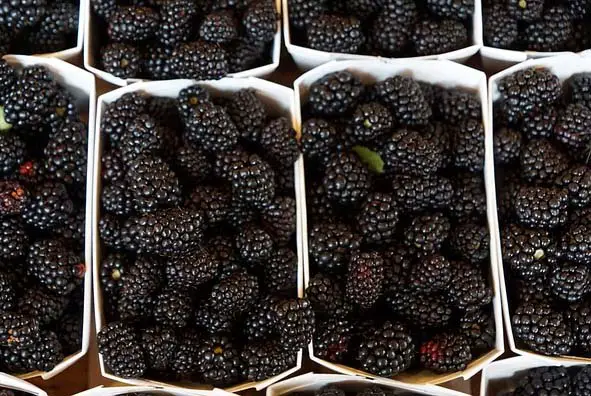
Growing blackberries at home is incredibly rewarding. You might occasionally be able to buy some really sweet, big, juicy berries at the grocery store, but more often than not the berries you bring home are sour and mediocre – not to mention expensive. But when you grow them yourself and pick them at the peak of ripeness, the flavor is far superior (and the price is right!).
The selection of blackberry cultivars in online nurseries can be overwhelming. You may have a better chance at a local nursery, but then the few choices available may seem too limiting. And buying blackberry plants at a big box store kind of feels like cheating…what if there’s something better out there?
In this article, I’m breaking down some popular blackberry varieties based on the characteristics a home grower might be looking for. What are the sweetest blackberries you can grow? The biggest? Best thornless varieties? Most winter-hardy? Best for small spaces? You can find answers to these questions (plus a couple more) here in one spot, rather than trying to read between the lines of the nursery’s plant tag sales pitch.
These lists are meant to give you a starting point for choosing varieties to make up your blackberry patch. I’ve kept them limited to cultivars that are fairly widely available. The recommendations are based on my own experience, that of other growers, and a ton of research – so you don’t have to do it!
Sweetest Blackberry Varieties
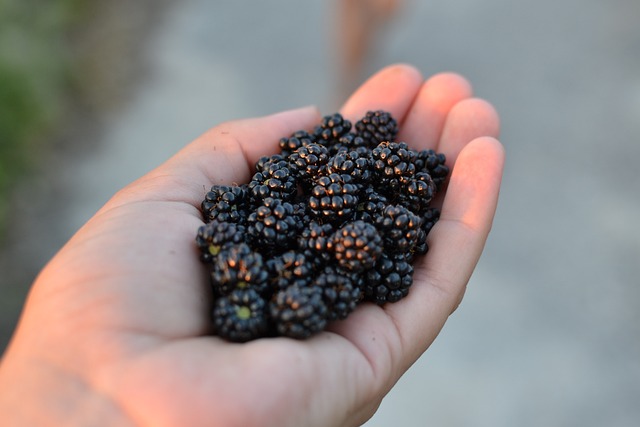
There’s a big difference in taste between perfectly ripe, sweet blackberries and those that are underripe and still sour. It certainly comes down to picking the berries at the right time, but it also depends on the cultivar. Some blackberry varieties, like those listed below, have a higher sugar content than others and will be more consistently sweet.
Learn more: Why are my Blackberries Sour? Tips to Grow Sweeter Berries
- ‘Navaho’ – This cultivar will appear on several of the lists in this article. It’s one of the best all-around blackberries to grow, largely because of its high sugar content. Zone 6-10.
- ‘Apache’ – Apache’s berries are not only very sweet, but they’re also one of the largest blackberries. It grows on erect canes and is quite cold hardy for a thornless variety.
- ‘Darrow’ – Darrow is one of the sweetest thorny varieties available, and is also one of the cold-hardiest. It fruits in late summer, and in some climates it can have a bumper crop in fall.
- ‘Triple Crown’ – This is another favorite of growers for its best qualities: flavor, vigor, and productivity. ‘Triple Crown’ is a reliable producer of sweet, relatively large berries.
Biggest Blackberry Varieties
One of the major advantages to growing your own blackberries is the ability to choose the characteristics you want your berries to have. Huge blackberries are rare in the grocery store, but possible in your garden.
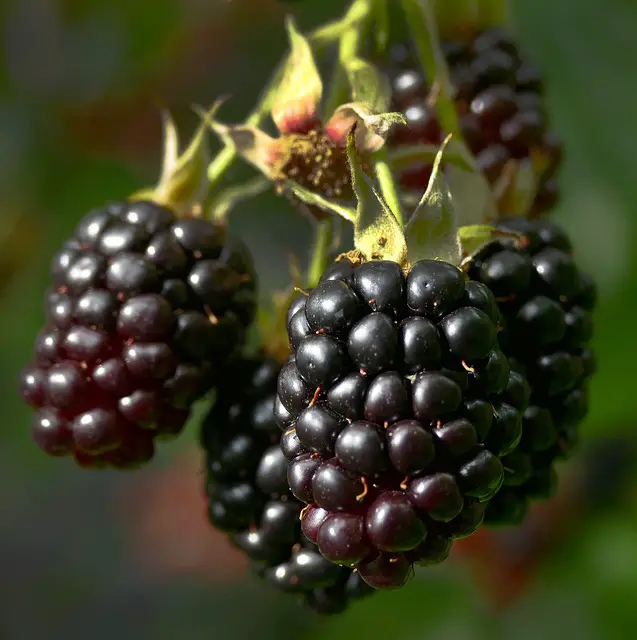
There are some things you can do to ensure that any variety grows to be as large as possible. Find out more here: 6 Ways to Grow Bigger, Juicier Blackberries.
- ‘Kiowa’ – ‘Kiowa’ grows massive berries over a long harvest season. The fruit is firm and mild flavored and can be up to 3 inches long, probably the largest of any cultivar.
- ‘Columbia Giant’ – This is an extremely high-yielding thornless blackberry cultivar. The berries grow very large, 2 to 3 inches long, with a mild tartness and slight raspberry flavor.
- ‘Triple Crown’ – This is one of the best all-around blackberries for home growers because of its sweet flavor and large berry size, among other things. The berries are harvested midseason.
- ‘Black Satin’ – In addition to growing large berries, ‘Black Satin’ is also one of the most heat-tolerant blackberry varieties. It has a great sweet honey flavor and ripens in midseason.
Best Thornless Blackberry Varieties
In recent decades, plant breeders have developed thornless varieties whose flavor rivals (or surpasses) the best classic thorny varieties. Not only are they thorn-free, but these varieties are productive, vigorous, and often have improved disease resistance as well.
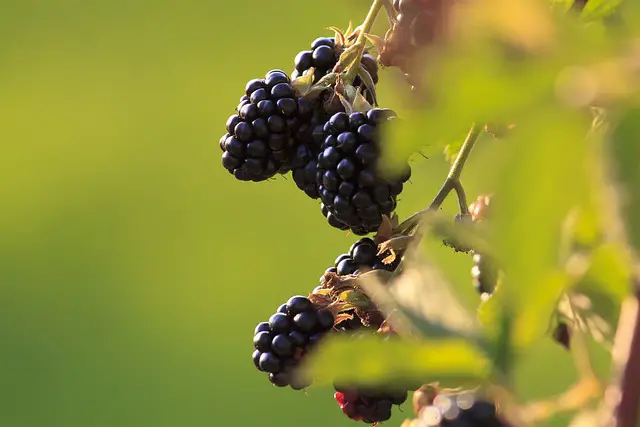
Check out The Best-Tasting Thornless Blackberry Varieties (9 Top Picks) to learn how to grow these and other thornless cultivars.
- ‘Navaho‘ – ‘Navaho’ is generally agreed to be one of the best-tasting blackberry varieties. The berries are medium to large and very sweet. Navaho ripens midseason – late June to early July in warmer climates. It’s also disease resistant and somewhat tolerant of heavy, clay soils.
- ‘Apache‘ – ‘Apache’ produces huge berries and robust harvests. They are firm and sweet with a pleasant mild tartness. ‘Apache’ is also quite cold hardy for a thornless variety, and may even tolerate as cold as zone 5 with some winter protection.
- ‘Arapaho‘ – The berries from ‘Arapaho’ are notable for good all-around flavor and very small seeds, and they ripen early in the season. ‘Arapaho’ is quite cold hardy and very disease resistant.
- ‘Ouachita‘ – ‘Ouachita’ has it all – large, sweet berries, good disease resistance, high yields, and a long harvest season. The berries have a longer-than-average shelf life once picked.
Most Cold-Tolerant Blackberry Varieties
Blackberries are a popular home-grown fruit in warm climates, but many varieties are also suitable for growing in areas with harsh winters. The following cultivars are some of the most likely to not only survive winter weather, but also continue producing fruit.
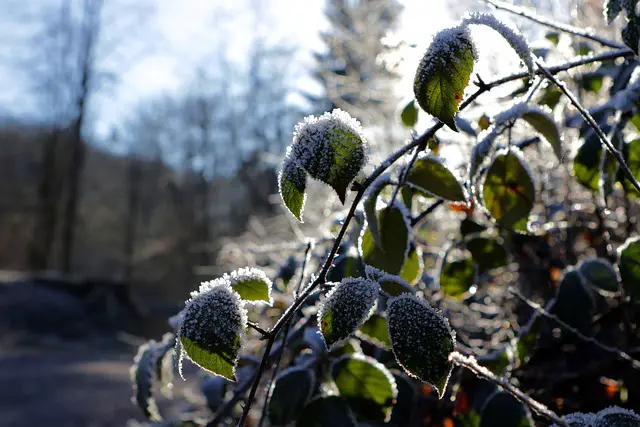
It may be necessary to protect blackberry plants over the winter to give them the best chance of fruiting the following spring. Check out The Best Blackberry Varieties for Cold Climates to find out how to do this, and to discover more hardy blackberry cultivars.
- ‘Illini Hardy’ – This cultivar is known as the most cold-hardy of all blackberries, tolerating at least as low as -25°F. It grows medium-sized berries with a mild flavor that are harvested in July. Not only will it survive harsh winters, but ‘Illini Hardy’ is tolerant of late spring frosts as well.
- ‘Chester’ – ‘Chester’ isn’t quite as hardy as ‘Illini’, but it has better flavor. It can be grown in zone 5 and possibly pushed further north with some winter protection. It’s a thornless, semi-erect variety that ripens in late July or August.
- ‘Darrow’ – ‘Darrow’ is a very productive thorny cultivar and grows large berries that taste similar to wild blackberries. It’s hardy to zone 5 (possibly 4b), and it also shows some resistance to rust.
- ‘Black Satin’ – ‘Black Satin’ is one of the most cold-tolerant thornless cultivars and can be grown in zone 5 (possibly 4b with winter protection). The berries are large, sweet, and high-yielding.
Disease Resistant Blackberry Varieties
Many of the more recent blackberry cultivars, especially the thornless ones, were developed with improved disease resistance. The four listed below are varieties proven to have few issues with diseases, although there are certainly others (‘Navaho’, ‘Darrow,’ and ‘Natchez’, for example).
Related: Blackberries Turning Red? Here’s What’s Happening
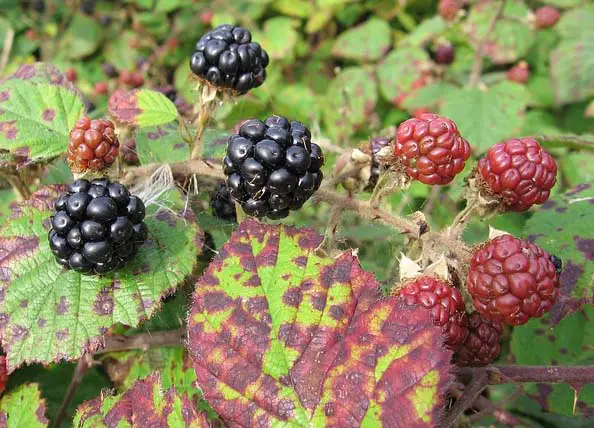
- ‘Triple Crown’ – In addition to its other attributes listed in this article, ‘Triple Crown’ is also highly disease resistant. It shows resistance to anthracnose, double blossom, crown gall, verticillium wilt, and root rot.
- ‘Ouachita’ – ‘Ouachita’ is highly disease resistant as well as heat- and humidity-tolerant. It resists rosette disease (also called double blossom), anthracnose, and orange rust, among others.
- ‘Arapaho’ – This cultivar is especially resistant to double blossom and rust. It also shows resistance to cold injury, and is one of the most reliably good-tasting varieties.
- ‘Prime Ark Freedom’ – This is a fall-bearing blackberry that is very disease resistant, particularly to rust. It has very large fruits that ripen on 1-year-old canes.
Best Fall-Bearing (Everbearing/Primocane) Blackberry Varieties
These blackberries bear fruit in the fall on 1-year-old primocanes, in addition to (or instead of) a summer crop on 2-year-old floricanes. In most cases, the fall berries grow from the tips of primocanes, and if the canes are left in place over the winter, the remaining buds will fruit the following summer. Unless you cut down all the canes after fruiting in fall, this means you’ll get two crops of berries each year.
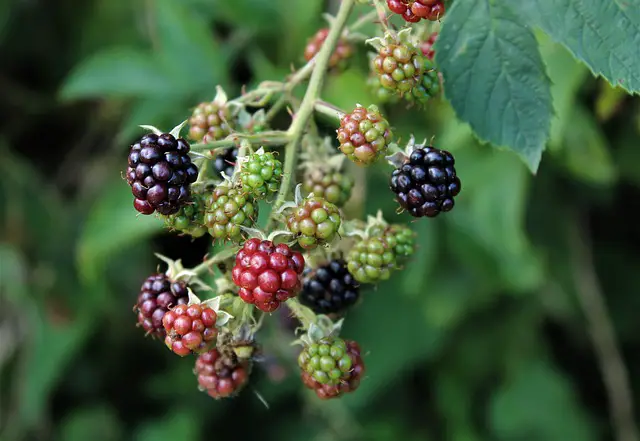
Excessive heat inhibits the primocane crop, however, although a smaller fall harvest may mean a larger summer harvest. Also, if you live in an area with early frosts, fall-bearing blackberries may not have time to ripen before the cold.
- ‘Prime Jan’ – This thorny, semi-erect/trailing cultivar will bear a long harvest on both primocanes and floricanes, beginning in June and continuing in frost. The flavor is mildly sweet, although not as sweet as many floricane varieties.
- ‘Prime-Ark 45’ – This cultivar produces mildly sweet, good-flavored berries on thorny, erect canes. It has good yields of both primocane and floricane fruit.
- ‘Prime-Ark Freedom’ – ‘Freedom’ is the first ever available thornless primocane blackberry variety. Its berries are very large and sweet, but need to be eaten relatively quickly after picking (they don’t last as long as some other varieties once picked).
- ‘Prime-Ark Horizon’ – This is a new cultivar from the University of Arkansas breeding program (as are the other ‘Prime-Ark’ varieties), released in 2020. The reports are that it has very high yields with a good flavor and texture similar to ‘Prime-Ark 45.’
Best Compact Blackberry Varieties
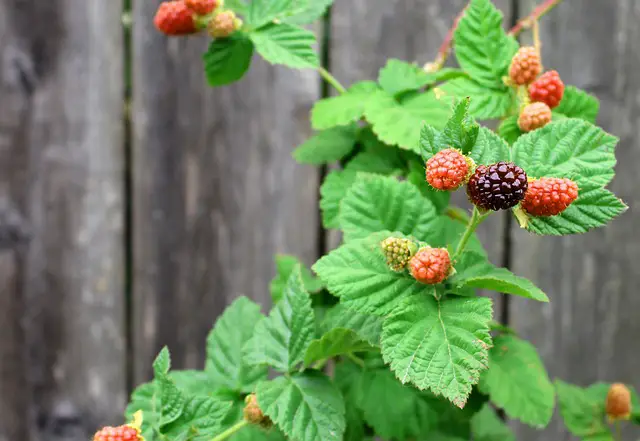
There aren’t too many blackberry varieties suitable for small spaces, since blackberries are brambles that like to sprawl and spread. But the following plants will stay compact and well-behaved, and still provide a great crop of berries.
- ‘Baby Cakes‘ – Bushel and Berry ‘Baby Cakes’ blackberry is a great choice for small spaces and containers. It stays upright and grows to 3-4 feet tall at most. Berries are harvested twice – in the fall on primocanes, and the following summer on floricanes. The fruit is large, firm, sweet, and productive.
- ‘Black Cascade‘ – This is a thornless, compact, trailing variety. It is perfect for growing in containers or hanging baskets. The berries form both on 2-year-old canes in summer, and sometimes on primocanes in fall. This was a popular cultivar after it was introduced in 1940, but is less widely available now. USDA zone 7-9.
- ‘Little Black Prince‘ – ‘Little Black Prince’ is a compact, upright, fall-bearing blackberry that will stay only a few feet tall. It fruits on new primocanes in the fall, although there may be a summer crop on the lateral growth of floricanes if they are left unpruned over the winter. The berries are medium sized with a balanced sweet-tart flavor. Currently only available in the UK and Europe.

